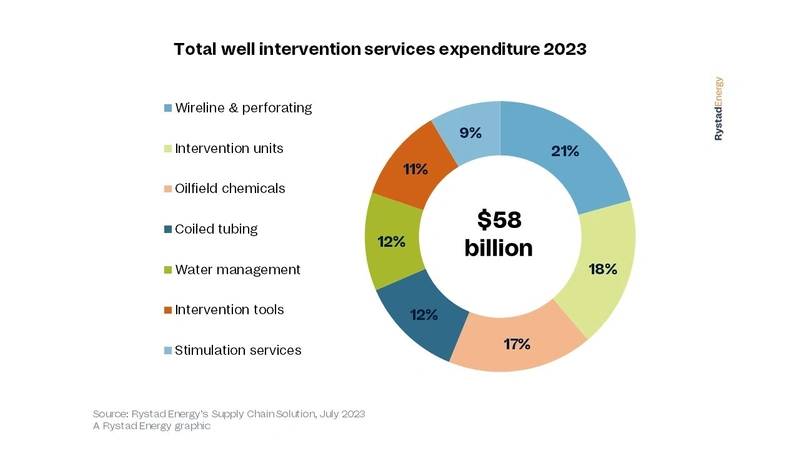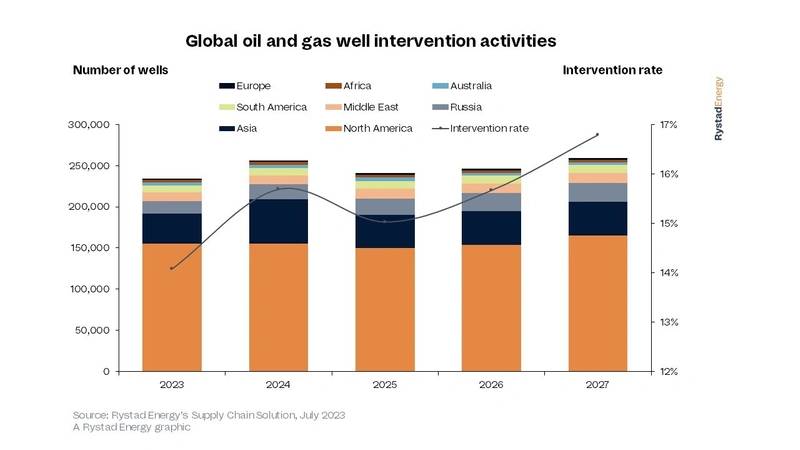
Oil and gas companies are set to spend $58 billion on well intervention – a way to extract additional resources from an existing well instead of drilling a new one – in 2023, the Norwegian energy intelligence group Rystad Energy said.
Rystad Energy said its modeling showed this is just the start of a surge in the coming years as the focus on efficiency intensifies.
The intervention rate – how many oil and gas wells go through the intervention process – is forecast to reach 17% in 2027. This would total about 260,000 wells globally.
More than $11 billion of the total expenditure will be directed to the wireline & perforating segment, while together, intervention units and oilfield chemicals sectors will represent 35%. In addition, the sum of the investments in coiled tubing, water management, and intervention tools is expected to close 2023, surpassing $20 billion.
"To boost production rather than drill new wells, operators are more likely to undertake intervention into mature assets that have been producing for more than five years, with relatively high production rates which are starting to show signs of decline," Rystad said.
Onshore interventions in Asia, South America, and Africa will lead the 9% growth in activities related to intervention during 2024, a year expected to be significant for the well intervention market. North America is projected to account for 64% of the total oil and gas wells ready for intervention in 2027, whereas Asia and South America will reach their maximum in 2026, with respectively 41,413 and 9,703 wells.
“As oil demand picks up in the second half of this year, operators will look to ramp up production from existing fields, and well interventions will be a vital piece of the puzzle. As a quick, efficient, and cost-effective method of maximizing existing resources, interventions are going to be a hot topic in the years to come,” says Jenny Feng, supply chain analyst at Rystad Energy.


Rystad Energy has developed a scorecard for evaluating conventional producing wells that allows us to quantify the overall intervention market and individual asset potential.
Four key market drivers factor into the scorecard: Well age, as older wells require more maintenance to sustain a consistent production rate; Average production rate; Remaining lifetime of the asset; Breakeven oil price
Each of these influences operators’ decision-making process when considering whether to drill new wells or explore intervention opportunities. These scores allow us to rank assets and countries by intervention market potential.
Since intervention suppliers currently have limited access to Russia’s oilfield services market, Russia is omitted from these scores, but it is included in the macro market view above. Only conventional assets with more than five active wells between 2023 and 2024 have been considered in our scorecard, so North America – Canada, the US, and Mexico – is excluded from the model due to its unconventional assets.
A distinct geographical focus is observed when looking at high-intervention potential assets. Algeria and Saudi Arabia are the top two onshore markets, adding up to more than 11,000 wells with exceptional intervention opportunities from 2023 until 2028.
Brazil, a country traditionally attractive for offshore explorations, represents almost 17% of the total top five intervention count, followed by Libya and Indonesia.
In terms of offshore markets, 618 assets are highly attractive for intervention. Norway and Australia stand out with 36% and 25%, respectively, while the UK scored an average of 3.05 because of the 91 wells likely to be involved in intervention activities.



